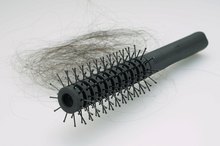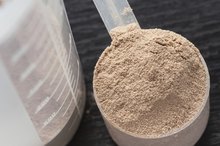Creatine and Glutamine Side Effects
Creatine and glutamine are two amino acids -- building blocks of protein -- commonly taken as supplements alone or together for purported sports performance benefits such as increasing lean mass and endurance. As with all supplements, taking creatine and or glutamine may cause unwanted side effects. Both amino acids are present in protein foods. Meat is particularly rich in creatine and glutamine. Talk to your doctor before taking creatine and glutamine supplements, especially if you have any existing health conditions.
Creatine and Glutamine Uses
Creatine is found throughout your body, where it serves as a source of fuel, particularly for your muscles. During high-intensity exercise such as weight training, your body converts the active form of creatine -- phosphocreatine -- to a source of energy your muscles can use to fuel themselves. Glutamine is stored primarily in your muscles also, but its role is different. It plays a major role in removing excess ammonia, which can build up during prolonged exercise. Glutamine also plays a role in immune health and wound healing.
- Creatine is found throughout your body, where it serves as a source of fuel, particularly for your muscles.
- It plays a major role in removing excess ammonia, which can build up during prolonged exercise.
Creatine Side Effects
Is Creatine a Safe Supplement for Teenagers?
Learn More
Side effects of creatine use are typically mild and may go away with continued use. Potential side effects include nausea, dehydration, diarrhea, muscle cramps and kidney problems. Creatine increases the amount of water your body retains, which may lead to a 1- to 3-pound weight gain in the first week of use, according to Quinnipiac University. Because creatine draws water into the muscle, the risk of dehydration increases. Drink plenty of fluids when taking creatine. Avoid creatine if you have kidney problems since it increases the workload on your kidneys.
- Side effects of creatine use are typically mild and may go away with continued use.
- Avoid creatine if you have kidney problems since it increases the workload on your kidneys.
Glutamine Side Effects
Taking glutamine may cause side effects such as nausea, abdominal discomfort, gas and constipation. A small percentage of users have reported experiencing chest pain, hemorrhoids, vomiting, dry mouth, back pain, depression, increased thirst, dehydration, rash, increased sweating, liver dysfunction and flu-like symptoms related to glutamine use, according to Drugs.com. There is a small chance that taking glutamine may aggravate existing gastrointestinal conditions such as gastric ulcer, Crohn's disease and pancreatitis.
Supplement Safety
Glutamine and Hair Loss
Learn More
Discontinue use and talk to your health care provider if you experience troublesome side effects related to taking creatine or glutamine or both. Side effects are commonly linked to taking high doses. The typical maintenance dose of creatine is 2 grams daily for exercise performance, according to the University of Maryland Medical Center. Most data shows no significant side effects at typical doses of creatine used for up to six months, according to the UMMC. Doses of 500 milligrams one to three times daily are considered safe for glutamine, according to the UMMC.
- Discontinue use and talk to your health care provider if you experience troublesome side effects related to taking creatine or glutamine or both.
- Most data shows no significant side effects at typical doses of creatine used for up to six months, according to the UMMC.
Related Articles
References
- University of Maryland Medical Center: Creatine
- University of Maryland Medical Center: Glutamine
- Quinnipiac University: Side Effects of Creatine Use
- Drugs.com: Glutamine Side Effects
- Cooper Institute: Creatine Supplements: Friend or Foe for Exercise Performance?
- Kreider, R. B. International Society of Sports Nutrition position stand: safety and efficacy of creatine in exercise, sport, and medicine. Journal of International Society of Sports Nutrition. 2017; 14: 18.
- MedlinePlus. Creatine.
Writer Bio
Janet Renee is a clinical dietitian with a special interest in weight management, sports dietetics, medical nutrition therapy and diet trends. She earned her Master of Science in nutrition from the University of Chicago and has contributed to health and wellness magazines, including Prevention, Self, Shape and Cooking Light.









